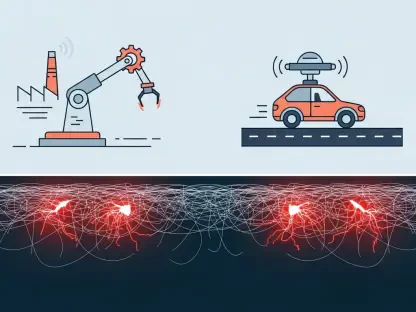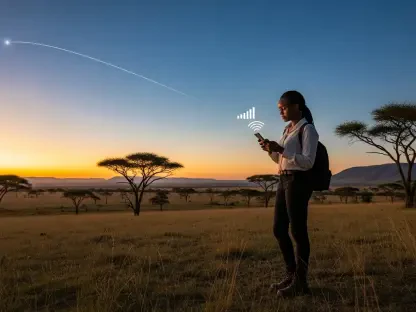The field of wireless communication is on the brink of a significant transformation, thanks to a groundbreaking advancement in antenna technology. Spearheaded by Professor Chan Chi-hou of City University of Hong Kong (CityUHK), a team of researchers has developed a novel metasurface antenna that promises to revolutionize the efficiency and potential of future 6G networks. This innovation is set to overcome the limitations of traditional antennas and open new avenues in communication systems.
Unprecedented Technological Capabilities
Simultaneous Frequency Generation and Control
One of the main highlights of the novel metasurface antenna developed by Professor Chan Chi-hou and his team is its ability to simultaneously generate and control multiple frequency components. This versatile feature represents a remarkable departure from traditional antenna technology, which is typically fixed in its capabilities and limited to specific frequency ranges. The synthetic moving-envelope technology proposed by the research group allows for the simultaneous generation of arbitrary harmonic frequencies, significantly enhancing the functionality and efficiency of communication systems.
The breakthrough lies in utilizing software to manipulate these harmonic frequencies, coupled with the ability to control their wave properties. This advancement enables unprecedented flexibility and precision in tuning the antenna’s performance, providing an essential foundation for future wireless communication systems. The metasurface antenna’s ability to manage multiple frequency components concurrently allows for more robust and adaptable communication capabilities, essential for the sophisticated demands of next-generation networks.
Enhanced Channel Capacity
The innovative capabilities of the metasurface antenna extend beyond frequency generation, significantly impacting the channel capacity of communication systems. By enabling the transmission of multiple signals in various directions simultaneously, the antenna dramatically increases channel capacity. This improvement is crucial for developing more robust and efficient communication systems, which are fundamental for next-generation large-capacity and high-security information systems.
With conventional antennas, the fixed frequency ranges and limited functionalities have often been a bottleneck in achieving higher channel capacities. However, the metasurface antenna’s simultaneous multi-frequency control paves the way for processing and managing numerous communication links concurrently. This capability boosts the overall system performance, ensuring higher data throughput, reduced latency, and enhanced security. As the demand for faster and more reliable wireless communication continues to grow, this enhancement in channel capacity marks a pivotal step toward realizing the full potential of future 6G networks.
Applications and Implications
Diverse Potential Uses
The implications of the metasurface antenna technology are vast and transformative, with potential applications extending across multiple fields. One notable area is real-time imaging, where the ability to control arbitrary harmonic frequencies through software manipulation can significantly improve image resolution and processing speed. In wireless power transfer, the technology offers enhanced efficiency and precision in delivering power to devices wirelessly.
Moreover, the prospects of integrating the metasurface antenna into photonic systems open new possibilities in integrated photonics. By enabling precise control of light at various frequencies, the technology could lead to more efficient and compact photonic devices. The seamless manipulation of frequencies extends the applications of this technology to various fields, such as cognitive radar and quantum science, where precise control over electromagnetic waves is crucial. This versatility underscores the transformative potential of the metasurface antenna in reshaping numerous technological landscapes.
Integration of Sensing and Communication
A cornerstone of the metasurface antenna’s innovation is its ability to seamlessly integrate sensing and communication functionalities. This feature is especially vital for the evolution of 6G networks, where the amalgamation of these functionalities is essential for enhanced performance and efficiency. The synthetic moving-envelope technology plays a pivotal role in achieving this integration, elevating spectral controllability and enabling sophisticated communication strategies.
Through a straightforward 1-bit coding strategy, the metasurface antenna can effectively combine sensing and communication, ensuring optimal utilization of the spectral resources. This integration extends beyond traditional communication applications, impacting areas such as cognitive radar, where the dual capabilities can be harnessed to achieve more accurate and reliable sensing and monitoring. The seamless integration of these functionalities not only propels wireless communication systems forward but also paves the way for innovative solutions in various technologies.
Advancements in Spectral Control
Synthetic Moving-Envelope Technology
The introduction of synthetic moving-envelope technology represents a significant leap in spectral controllability. This technological advancement facilitates the independent control of harmonic orders, allowing for more precise and versatile use of the electromagnetic spectrum. Unlike conventional antennas, the metasurface antenna utilizes a straightforward 1-bit coding strategy, enhancing its efficiency and simplicity. This coding strategy enables the antenna to manipulate various spectral components seamlessly, providing a higher degree of controllability compared to its predecessors.
The novel technology not only enhances spectral efficiency but also broadens the scope of applications by offering superior flexibility in controlling and manipulating different frequency components. This elevated spectral control is particularly beneficial for applications requiring dynamic and adaptive frequency management, such as cognitive radar systems and integrated photonics. The inherent simplicity and effectiveness of the synthetic moving-envelope technology mark it as a significant milestone in the ongoing evolution of wireless communication systems.
Sideband Proofing and On-Chip Integration
In addition to the advanced spectral controllability, the metasurface antenna’s design inherently includes sideband-proofing capabilities, further distinguishing it from traditional antenna technologies. Sideband proofing ensures that the antenna can operate efficiently without interference from adjacent frequency bands, thereby enhancing its performance and reliability. This feature is crucial for maintaining the integrity of communication systems, especially in environments with high-frequency congestion.
Moreover, the potential for on-chip integration sets the metasurface antenna apart, paving the way for more compact and efficient wireless communication devices. The integration of the antenna onto chips ensures that it can be seamlessly incorporated into various electronic devices, enhancing their functionality and performance. This advancement holds promise for a wide range of applications, from wireless communication and cognitive radar to quantum science and integrated photonics. The combined benefits of sideband proofing and on-chip integration underscore the transformative potential of the metasurface antenna technology in shaping future communication systems.
Collaborative Efforts
Joint Research Endeavor
The successful development of the novel metasurface antenna is a testament to the collaborative efforts and interdisciplinary approach of the research team. The project is a joint endeavor between City University of Hong Kong (CityUHK) and Southeast University in Nanjing, China. This collaboration underscores the importance of pooling expertise and resources from multiple institutions to achieve groundbreaking advancements in technology. The partnership between the two universities has facilitated a robust exchange of ideas and insights, driving the development of the metasurface antenna forward.
Such interdisciplinary collaboration is critical in addressing the complex challenges associated with advancing wireless communication systems. The combined efforts of researchers from diverse backgrounds have enabled the synthesis of innovative solutions and the successful implementation of the synthetic moving-envelope technology. This collaborative approach not only accelerates the pace of technological innovation but also ensures that the developed solutions are comprehensive and well-rounded, capable of addressing various aspects of wireless communication.
Contributions from Prominent Researchers
The field of wireless communication stands on the verge of a dramatic transformation, thanks to an innovative development in antenna technology. Led by Professor Chan Chi-hou from CityUHK, a team of dedicated researchers has created a pioneering metasurface antenna designed to revolutionize the efficiency and potential of future 6G networks. This cutting-edge innovation is anticipated to transcend the limitations imposed by traditional antennas, opening new possibilities in communication systems. With 6G technology on the horizon, the need for more efficient, reliable, and versatile communication is paramount. The metasurface antenna, unlike its predecessors, offers a combination of enhanced performance and adaptability. By utilizing advanced materials and novel design principles, this new antenna will not only support higher data rates but also improve signal quality and energy efficiency. The implications of this breakthrough are vast, potentially impacting various industries, from telecommunications to autonomous vehicles and beyond, heralding a new era in the connectivity landscape.









